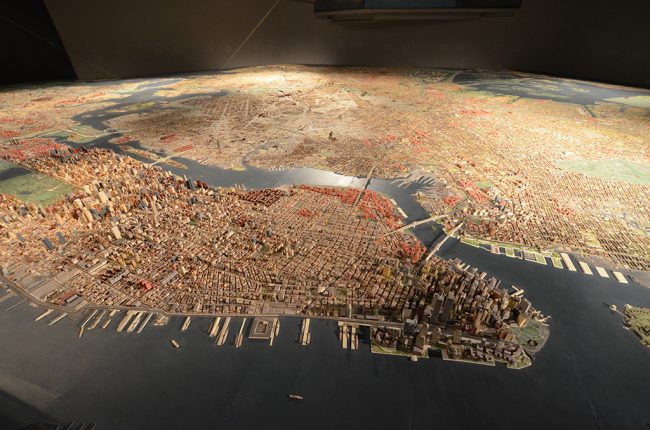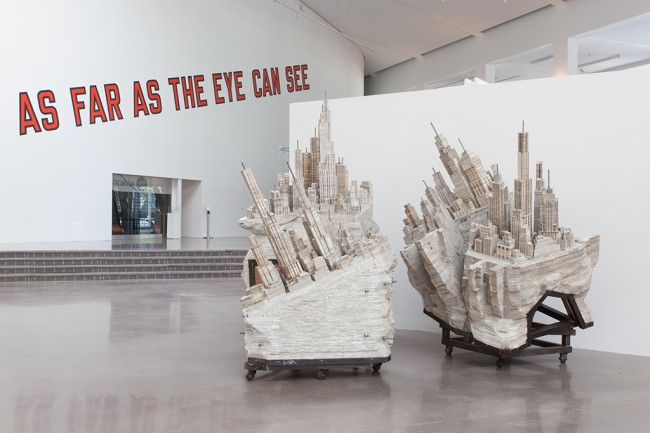
We are celebrating 15 years — and counting — of stories that are deeply researched and deeply felt, that build a historical record of what the city has been.
We are celebrating 15 years — and counting — of stories that are deeply researched and deeply felt, that build a historical record of what the city has been.
I can’t think of a more fitting a place for an exhibition of art and representation that aims to capture the breadth of the world than the Queens Museum. The institution continues to break through the walls of its recently renovated New York Pavilion building — a remnant of the 1964 World’s Fair, an event that sought to bring the world to Queens — with a range of community initiatives, forswearing the insular museum tradition. Through these initiatives, it invites in and responds to a borough with one of the most diverse populations in the United States — the world within the five boroughs.

The Panorama of the City of New York, created by Raymond Lester Associates | Photo by Chris Devers
The title of Bringing the World into the World, on view through October 12th, is inspired by Italian artist Alighiero Boetti’s assertion that art and the world contain and are contained by each other. As conceived, the exhibition couldn’t happen properly anywhere else. Its pieces all draw inspiration or operate in dialogue with the majestic Panorama of the City of New York, the world’s largest model of an urban environment. The Panorama alone is well worth a visit to the Museum. After 50 years it is still unique in its ability to show the vast scope of New York City. If there is any danger in constructing the exhibition around the Panorama, it’s that once inside the sprawling model’s inner chamber, I found it difficult to break away to take in the other pieces. I like to think that the curatorial staff experienced this same impulse, one reason why they installed pieces within the Panorama room that interrupt its trance. Ray and Charles Eames’ film Powers of Ten glows beneath one of the transparent walkways stretching out over the Panorama — a perfect perch for the film’s zooming from human scale out to the universal and down to the atomic. And suspended above the Bronx floats the sun in Chris Burden’s Scale Model of the Solar System, with ball bearings representing Mercury, Venus, Earth, and Mars nearby. Neptune sits in the Mexican restaurant Tortilleria Nixtamal a couple of blocks outside the park, the rest of our solar system sprinkled in eateries or parkland surrounding the museum. While you are taking in the horizontal expanse of the city, you are reminded of all that surrounds you, the molecular to the planetary.
Look up from the Panorama to the surrounding walls and you’ll see one of the most playful pieces in the exhibit. I almost missed the goose butt sticking out from the wall at an angle, as if the waterfowl had breached the Panorama’s container. Yumi Kori’s Flight led me out into the rest of the museum: the other half of the goose is peaking through the other side of the wall.
Other elements of the exhibition followed a similar mapping vein. Hikaru Hayakawa’s Panta Rhei (4,000 years of human history) charts just that through copper piping inscribed with the names of civilizations morphing into our modern nation-states. The tangle of pipes, intersections and branches representing conflicts and length denoting time in existence, physically embody human societies in a beautiful object. Hayakawa’s Study/2014 does something similar in the form of a wall drawing produced specifically for the exhibition. Harun Farocki’s Deep Play latches on to a different element of mapping, the layering of perspectives upon a common base. His 12-channel video installation displays expansive documentation of the 2006 World Cup Final between France and Germany: in addition to footage of the game itself and video of individuals watching the game, Farocki includes simulations of the play used by sports analysts and security tape from around the stadium. The air of surveillance that pervades the piece is unsettling, particularly so for its supposedly playful subject. This same concern with perspectives, and complication of what is the “true” point of view, is at hand in Tavares Strachan’s Magnetic. Two screens richer than Deep Play, the piece consists of seven films of the artist’s approach to the North Pole from different directions, physically backed by seven films displaying the surrounding landscape. Though the North Pole is supposed to be a highly specific place, Strachan’s footage of 14 views of a monotonous arctic expanse questions whether claiming to plot such a spot is even possible or relevant.
This skepticism of the geographic authority that the hyper-detailed Panorama represents runs throughout the exhibition. Clarissa Tossin balls up tracing paper and sketches a globe, only to unfold that representation into a vaguely recognizable but scattered new view of the world in Unmapping the World. And in what may be the most attractive sculpture possible for an avid reader and urbanist, Liu Wei presents a fractured cityscape constructed from books, breaking apart what seems so coherent and rational in the Panorama. Even the triumphant lettering of Lawrence Weiner’s As Far As the Eye Can See, composed of those words emblazoned across a wall in four-foot tall letters (as if an airplane were just ahead, pulling the banner behind), seems to make fun of just how constrained a view the eye, and human perception, actually provides.

Liu Wei’s Library II-II sits in front of Lawrence Weiner’s As Far As the Eye Can See | Photo courtesy of the Queens Museum
This dissonance is what makes the exhibition worthy of praise from both artists and urbanists. It juxtaposes pieces that reach the heights of our belief that we can somehow fully capture the world around us with those that complicate this endeavor, showing the myriad perspectives through which a single place or event can be perceived. Then, it critiques itself. I only wish I had more time to skim the books of Reanimation Library / Corona Branch — a curated collection of over 200 books from “the rapidly receding 20th century” on topics like the future, perception, cartography, and geography — to find some now-debunked simplifications of the world, or to fully understand what was going on in Wong Kit Yi’s Too Much Water, Too Much Wood, Lacking Fire, a series of sculptural and architectural interventions with embedded video of conversations between artists and curators arranged throughout the museum according to the practice of feng shui. Be sure to give yourself multiple hours to delve into this exhibition, which appears to have few artworks at first but quickly shows its vastness and depth. Whether it’s the world containing the art or the art containing the world that you are searching out, each will take a good bit of time to comprehend, and it’s well worth spending it.
The views expressed here are those of the authors only and do not reflect the position of The Architectural League of New York.